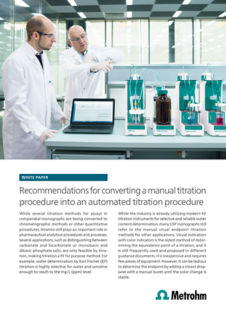OMNIS titrators are high-end automatic titrators for potentiometric titration that allow you to consolidate all your titration applications on a single platform for efficient and safe analyses. Various customization and automation options are available and, thanks to the modular design, you can scale up your system as you go.
Starting at USD $21,000 | CAD $27,500
- Your needs, your system: titration modes for volumetric and coulometric Karl Fischer titration (KFT) or thermometric titration (TET), automation, sample preparation, and more available
- Higher throughput: Five manual or four fully automated titrations can be performed at the same time
- Safe and contact-free reagent exchange: New patented Liquid Adapter system with 3S technology makes chemical handling easier
- Higher precision: Resolution of up to 100,000 steps for accurate results
- Higher reliability, reproducibility, and traceability of results: Modern and intuitive OMNIS Software
- Peace of mind: Compliance with FDA Regulation 21 CFR Part 11 and EudraLex, Volume 4, Annex 11
Brochure: OMNIS – Performance on a whole new level (8.000.5456, PDF, 1 MB)
Brochure: OMNIS Titrator (8.000.5448, PDF, 205 KB)
Brochure: Thermometric Titration with OMNIS – fast, simple, and reliable (8.000.5446, PDF, 588 KB)
Brochure: OMNIS Sample Robot (8.000.5450, PDF, 1.29 MB)

